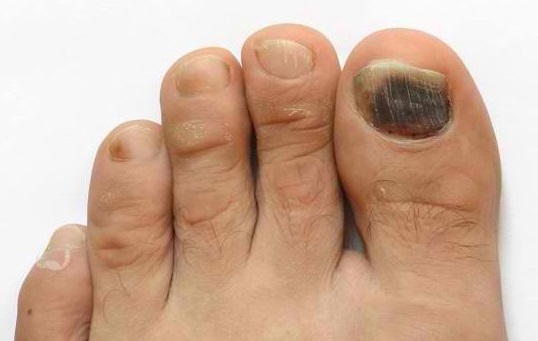- Home
- Common Foot Problems
- Tennis Toe
Tennis Toe
Written By: Chloe Wilson BSc(Hons) Physiotherapy
Reviewed By: FPE Medical Review Board

Tennis Toe occurs when damage to the toe causes bleeding resulting in blood collecting underneath a toe nail.
Tennis Toe most commonly affects athletes due to repetitive trauma to the toe and can be extremely painful.
Repeatedly injuring the toe leads to pooling of blood underneath the nail plate causing the nail to appear black or red. It is the big toe that is most commonly affected.
In most cases tennis toe can be treated at home and will settle down within a few weeks. More severe cases will need a medical review. It is also known as a "Subungual Hematoma" or "Runners Toe".
Here, we will look at the common causes, symptoms and treatment options, as well as how to prevent this painful condition from developing or recurring in the future.
What Causes Tennis Toe?
Tennis or Runners Toe is usually caused by repetitive pressure and friction on the nail when the toe is repeatedly jammed against the front edge of a shoe (known as the toe box). This action commonly happens when suddenly stopping, changing direction or pivoting when running, for example when running for a drop shot in tennis.
Tennis toe is most commonly associated with tennis, hence the name, but can also affect soccer, football, squash, racquet ball and basketball players as well as runners and skiers.
Tennis Toe Symptoms
Tennis Toe usually presents with throbbing pain under the nail. The nail plate is usually discoloured a reddish-blue/black colour due to the subungual hematoma and may become thickened and more brittle.
It tends to occur at the big toe, but can also affect the second toe. It is rare for it to present in the outer three toes.
A subungual hematoma is often the result of ill-fitting shoes. Shoes that are either too loose or too tight can increase the friction through the toe nail and lead to bleeding.
How Do You Treat Tennis Toe?
For mild cases of Tennis Toe, treatment is very simple. Cleaning the toe with antiseptic and covering it with a dressing will prevent further infection and allow healing.
The affected nail plate will gradually grow out and be replaced by a new healthy one, but this does take a few months.
With more severe cases when there is a lot of bleeding, swelling and/or infection, you should see your doctor or podiatrist. They may need to make a small hole in the nail to take the pressure off the subungual hematoma (collection of blood) which should drastically reduce the pain.
Occasionally, in severe cases your doctor may decide that part or all of the nail needs to be removed.
How To Prevent Tennis Toe
There are some simple measures you can do to redice the risk of developing Tennis Toe:
- Clip Your Toe Nails: Keep toe nails clipped short so they don’t extend past the end of the toe. That will reduce the pressure and friction, preventing a subungual hematoma from developing
- Good Footwear: Make sure you are wearing shoes that fit well. Some people swear by steel toe tennis shoes to prevent friction and squashing of the toes. They can take a few days to get used to as they are heavier than regular shoes, but they really can make a difference, especially if you are playing a lot of sport
- Taping: Tape the toe to the one next to it
- Play on the Right Surface: Tennis Toe is thought to be less common when playing on natural surfaces such as a grass or clay court rather than on synthetic surfaces
There are a number of other causes of toe pain. If this isn't sounding quite like your problem, visit the foot pain diagnosis section for help working out what is wrong and what you can do about it.
Related Articles
Page Last Updated: 10/04/22
Next Review Due: 10/04/24




